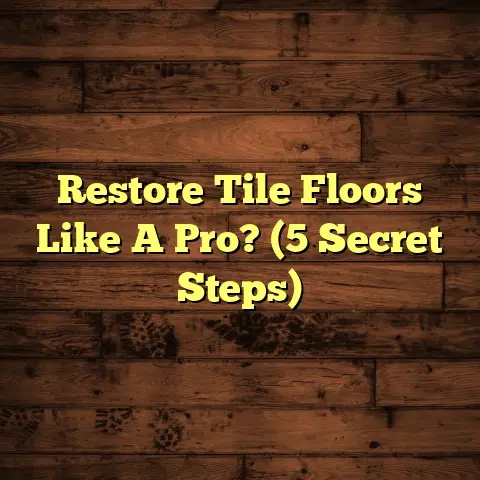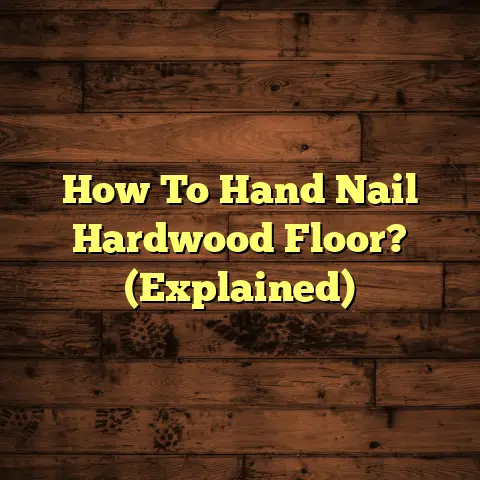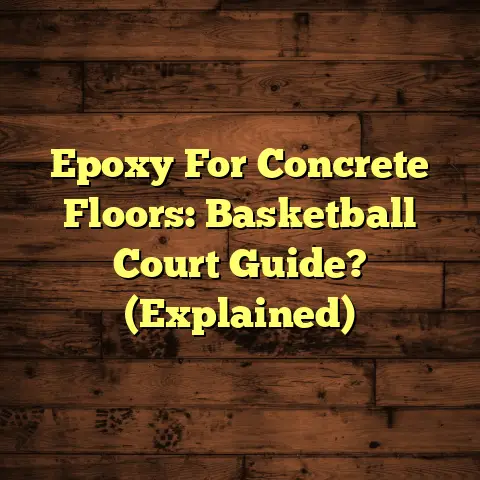Is It Better To Glue Or Float Hardwood Flooring? (Explained)
When installing hardwood flooring, one key decision is whether to glue the planks down or use a floating method. Both options have advantages and drawbacks depending on your flooring type, subfloor, and personal preferences. This article explains the differences between glued and floating hardwood floors to help you choose the best installation method for your project.
The Basics of Installation Methods
Glue-Down Installation Method
The glue-down method involves using adhesive to secure the hardwood directly to the subfloor. This method is commonly used for solid hardwood but is also applicable for engineered hardwood flooring.
Process:
- Preparation: The subfloor must be clean, dry, and level. A moisture barrier may be necessary depending on the environment.
- Applying Adhesive: A notched trowel is used to spread adhesive on the subfloor.
- Laying the Planks: Each plank is pressed into place, ensuring tight seams.
- Cleaning Excess Adhesive: Any adhesive that seeps out needs to be wiped away before it dries.
Floating Installation Method
Floating flooring relies on the interlocking mechanism of the planks rather than adhesive or nails. This method is especially common for engineered hardwood.
Process:
- Preparation: Similar to glue-down, ensuring a level surface is crucial.
- Underlayment: A foam underlayment is laid down to absorb sound and provide cushioning.
- Laying the Planks: Planks are clicked together side by side and end to end, floating above the underlayment.
- Trimming Edges: Baseboards or quarter round trim are added to cover expansion gaps around the perimeter.
My Personal Journey with Hardwood Flooring
When I first decided to install hardwood flooring in my home, I was overwhelmed by the options available. I initially went with gluing for my living room, thinking it would provide a more permanent and solid feel. After completing that project, I learned valuable lessons that shaped my approach to subsequent installations.
First Installation: Living Room with Glue-Down Method
In my 300-square-foot living room, I chose solid oak flooring. The cost for the wood was approximately $6 per square foot, totaling around $1,800. Adding in adhesives and tools, my total investment came closer to $2,200.
The installation took about two days from start to finish. Here are some reflections on that experience:
- Successes:
- The floor looked stunning once installed; the rich grain of the oak really stood out.
- I noticed a significant reduction in noise compared to my previous carpet.
- Challenges:
- I underestimated the amount of adhesive needed and had to make a late-night run to the store for more.
- Cleaning excess adhesive was tedious; I learned to keep a wet cloth nearby as I worked.
Second Installation: Basement with Floating Method
For my basement, I opted for an engineered hardwood floor that was easier to install and more resistant to moisture. The cost was about $4 per square foot for 400 square feet, totaling around $1,600.
Installing this floating floor took just one day, and here’s what I discovered:
- Successes:
- The interlocking system was intuitive; I completed the project much faster than expected.
- The flexibility of the planks allowed for minor adjustments as I worked.
- Challenges:
- Some boards didn’t click together as easily as others; this required patience and careful alignment.
- I noticed a bit more noise when walking on the floor compared to my glued-down option.
Analyzing Costs and Timeframes
One of the biggest factors in deciding between gluing and floating hardwood flooring is the cost and time involved in installation.
Cost Breakdown
- Gluing Costs:
- Solid Hardwood: $6-$8 per square foot
- Adhesive: About $0.75 per square foot
- Tools (trowel, roller): Approximately $100
- Total Estimate for 300 sq ft: $2,200 – $2,600
- Floating Costs:
- Engineered Hardwood: $4-$6 per square foot
- Underlayment: Around $0.50 per square foot
- Tools (cutter, tapping block): Approximately $50
- Total Estimate for 400 sq ft: $1,800 – $2,200
Timeframes
- Gluing Method: Typically requires 1-3 days depending on room size and complexity.
- Floating Method: Generally completed in 1 day for average-sized rooms.
Technical Specifications
Adhesives Used in Glue-Down Installations
Understanding the types of adhesives available can greatly influence your choice:
- Urethane Adhesive: Highly recommended for its strong bond and moisture resistance.
- Water-based Adhesive: Easier cleanup but may not provide as strong a bond in high-moisture areas.
Floating Floor Mechanics
The floating mechanism works through a tongue-and-groove design that allows planks to interlock without being secured to the subfloor. This feature can make repairs straightforward since individual planks can be removed without disturbing adjacent pieces.
Maintenance Considerations
Regardless of the installation method chosen, maintenance plays a pivotal role in the longevity of hardwood flooring.
Maintenance for Glue-Down Floors
- Cleaning: Regular sweeping or vacuuming is essential. Avoid excessive water when mopping; use a damp mop instead.
- Refinishing: Solid hardwood can be sanded and refinished multiple times. Plan on doing this every 5-10 years based on wear.
Maintenance for Floating Floors
- Cleaning: Similar cleaning practices apply; however, watch for moisture accumulation in seams which could lead to issues.
- Repairs: If a plank gets damaged, you can replace it without affecting surrounding pieces.
Environmental Considerations
As I explored flooring options, environmental impact became an important factor. Many companies now produce eco-friendly hardwood products sourced from sustainable forests or made from recycled materials.
When choosing between glue-down and floating options, consider:
- Air Quality: Some adhesives may emit VOCs (volatile organic compounds). Look for low-VOC options if air quality is a concern.
- Sustainability: Opt for manufacturers that practice sustainable forestry and responsible sourcing.
Case Studies: Real-Life Comparisons
To further illustrate the differences between gluing and floating methods, let’s look at two case studies based on friends who underwent similar installations.
- Case Study A: Sarah’s Glue-Down Experience
- Sarah installed solid cherry wood in her dining room using glue-down installation.
- Cost: Approximately $3,000 for materials and professional labor.
- Outcome: While her floor looked beautiful and felt solid, she faced issues with squeaking noises over time due to inadequate adhesive coverage in some areas.
- Case Study B: Mike’s Floating Installation
- Mike chose an engineered bamboo floor for his apartment using the floating method.
- Cost: Around $1,800 for materials.
- Outcome: He loved how quickly he could install it himself but experienced minor gaps forming between planks after a few months due to humidity changes.
Conclusion: Making the Right Choice
In conclusion, choosing between gluing and floating hardwood flooring ultimately depends on your specific needs, preferences, and circumstances. Both methods have their unique advantages and disadvantages that can affect your overall satisfaction with your flooring project.
From my experience:
- If you prioritize durability and don’t mind investing more time and money upfront, glue-down might be your best bet.
- If ease of installation and flexibility are higher on your list, then floating flooring could be ideal.
Consider all factors—costs, installation time, maintenance requirements, environmental impact—and choose what aligns best with your lifestyle and home environment. Remember that every home is unique; what works for one person may not be suitable for another. By weighing your options carefully and drawing from personal experiences like those I’ve shared, you’ll be better equipped to make an informed decision about your hardwood flooring installation.





